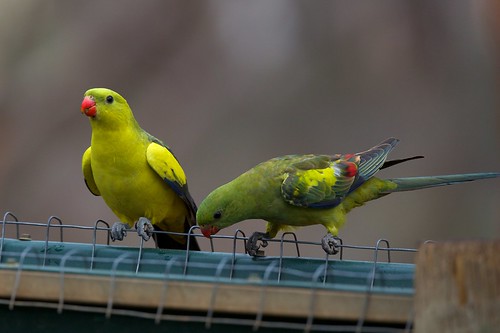 Pair of Regent Parrots on the fence. Image by sunphloResearchers from Charles Sturt University (CSU) working with Australia’s largest almond producer have found that some native birds are not simply pests as first thought, but provide important financial benefits to the almond grower.
Pair of Regent Parrots on the fence. Image by sunphloResearchers from Charles Sturt University (CSU) working with Australia’s largest almond producer have found that some native birds are not simply pests as first thought, but provide important financial benefits to the almond grower.
“Bird damage to crops is one of the biggest problems facing growers of a wide variety of horticultural crops in Australia, and many control techniques are often uneconomical or ineffective,” said Dr Peter Spooner, an ecologist with the University’s Institute for Land, Water and Society.
“Our research showed that the benefits of native bird interactions with crops, in most cases, far outweighed the costs of crop damage.”
Dr Spooner leads a project which aimed to develop better ways to maximise production and conservation outcomes of bird interactions in crops, looking particularly at the regent parrot.
This native parrot is threatened in Victoria and endangered in NSW, and the focus of a number of conservation programs in the Victorian Mallee region. The key habitat for the regent parrot coincides with areas now farmed for almonds, which has lead to some conflict in the management of the bird.
 Developing almondsDr Spooner’s project was a collaborative effort, with funding provided by the Australian Research Council, Select Harvests and Almond Board of Australia, Victorian Department of Environment and Primary Industries, the Mallee Catchment Management Authority, and the NSW Office of Environment and Heritage.
Developing almondsDr Spooner’s project was a collaborative effort, with funding provided by the Australian Research Council, Select Harvests and Almond Board of Australia, Victorian Department of Environment and Primary Industries, the Mallee Catchment Management Authority, and the NSW Office of Environment and Heritage.
The study was one of the first in Australia to show how tree crops such as almonds provide important conservation values for native species.
“Farm landscapes can provide important habitat values for many threatened and endangered species such as the regent parrot,” Dr Spooner said.
“Our analyses showed that the presence of almond crops enhanced existing native vegetation corridors, and strengthened the value of the broader landscape in providing better habitat for many native species.
“In mallee country such as found in north-west Victoria, most native vegetation on fertile soils has been cleared for cropping and grazing. Replacing these open areas with almond trees has provided important benefits for many native birds, such as shade, shelter and alternative food resources, particularly in times of drought.
“In return, some native species provide important services to farmers, such as natural disease and pest control.” said Dr Spooner.
In almond crops, birds such as regent parrots clean up “mummy nuts”, nuts left on trees post harvest that become a potential source of disease. By feeding on and removing these nuts, these birds provide significant financial benefits to growers.
Through their findings, the researchers recommended that the almond industry should price the beneficial services performed by parrots in almond crops, not just the costs of pest damage.
“To date, almond growers have focused on the costs of bird interactions in crops, such as the use of deterrents to scare off birds,” said Dr Spooner.
“This is understandable. A farmer sees the damage that birds do to their almond trees, which can be quite extensive in some locations, and therefore sees the birds as a threat to their livelihoods. However, our research has shown that the benefits of other bird interactions can offset these perceived losses, particularly when costed over large areas.”
To more effectively control bird damage in crops, the research team recommended that rather than try to frighten off birds, farmers provide alternative food sources or decoy crops. ILWS is currently looking into further research in this area.
The researchers believed conservation managers should also change their focus from protecting remnant native vegetation to a broader landscape approach which acknowledges the contribution of farms to conservation efforts.
“Native vegetation protection, enhancement and restoration activities will always be the cornerstone of conservation management approaches,” said Dr Spooner. “However, farm crops such as almonds also provide important habitat values. Conservation managers need to develop novel ways of working with almond growers to protect threatened species.
“For example, rather than implement standard intensive farming approaches farmers could be provided with incentives to manage almond crops in strategic locations in a more ‘traditional ’ sense, where nuts are manually harvested and the ground is left ‘messy’ - covered with grasses and other plants. This environment would provide many advantages for native species and still yield a crop.
“Remnant native vegetation and horticultural crops should not be managed in isolation. Relevant managers need to work together to produce better outcomes for farming and the environment.”